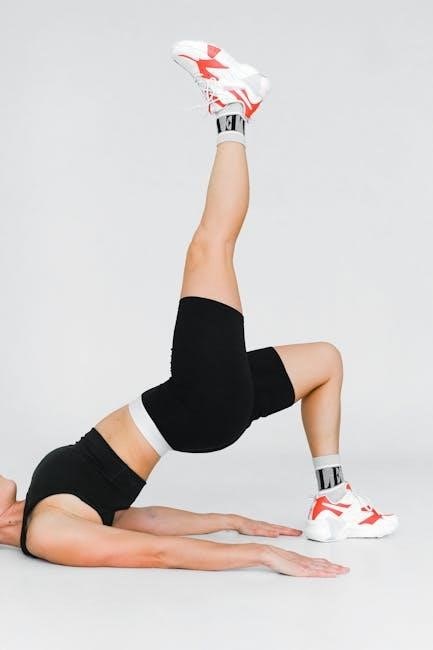piriformis stretch pdf

A comprehensive guide offering detailed exercises and routines to alleviate piriformis syndrome symptoms. Ideal for individuals seeking targeted stretches to relieve sciatic pain and improve hip mobility.
Overview of Piriformis Syndrome
Piriformis syndrome is a condition causing deep buttock pain and sciatica-like symptoms due to the piriformis muscle compressing the sciatic nerve. It often results from muscle tightness or inflammation, leading to pain radiating down the leg. Accurate diagnosis is crucial as symptoms can mimic other lower back issues, ensuring effective treatment.
Importance of Stretching for Piriformis Relief
Stretching is essential for relieving piriformis syndrome as it reduces muscle tightness and inflammation. Regular stretching improves circulation, eases sciatic pain, and enhances flexibility. It also prevents future flare-ups by strengthening the muscle and improving hip mobility. Incorporating targeted stretches into daily routines can significantly alleviate symptoms and support long-term recovery.
Understanding the Piriformis Muscle
The piriformis muscle, located near the hip joint, plays a crucial role in stabilizing and rotating the hip. Its proper function is vital for smooth movement and posture.
Anatomy and Function of the Piriformis
The piriformis muscle originates from the anterior surface of the sacrum and inserts on the greater trochanter of the femur. It primarily functions in hip external rotation, stabilization, and abduction. This deep gluteal muscle plays a key role in maintaining proper hip alignment and movement. When tight or inflamed, it can compress the sciatic nerve, leading to pain and discomfort.
How the Piriformis Contributes to Sciatica
The piriformis muscle can contribute to sciatica by compressing the sciatic nerve as it passes near or through the muscle. Tightness or inflammation in the piriformis can irritate the nerve, causing pain that radiates down the back of the leg. This compression often leads to symptoms associated with piriformis syndrome, such as buttock pain and sciatic nerve discomfort.
Types of Piriformis Stretches
Common stretches include seated, supine, standing, and modified variations. These exercises target the piriformis muscle, improving flexibility and relieving tension.
Seated Piriformis Stretch
Sit in a chair with your back straight, feet flat on the floor. Cross your right leg over your left thigh, placing your right ankle on your left knee. Gently lean forward to feel a stretch in your right buttock. Hold for 30 seconds, then repeat three times on each side. Avoid twisting your back during the stretch.
Supine Piriformis (Figure-Four) Stretch
Lie on your back with knees bent and feet flat on the floor. Cross your right ankle over your left knee, forming a figure-four position. Gently pull your left knee toward your chest until you feel a stretch in your right buttock. Hold for 30 seconds, then switch sides. This stretch helps relieve tightness and discomfort in the piriformis muscle while in a relaxed supine position.
Standing Piriformis Stretch
Place the heel of your injured leg on a stool about 15 inches high. Lean forward slightly at the hips until you feel a mild stretch in your buttocks. Keep your back straight and avoid twisting. Hold the stretch for 15-30 seconds, then switch sides. This stretch is effective for relieving tension in the piriformis muscle while maintaining an upright position.
Modified Piriformis Stretch
Cross the involved leg over the bent knee, resting your ankle on the opposite thigh. Gently press the knee downward until a stretch is felt in the buttocks or hip. Hold for 30 seconds, then repeat three times. This variation is ideal for those who find the supine stretch uncomfortable, providing a comfortable yet effective way to relieve piriformis tension.

Benefits of Stretching for Piriformis Syndrome
Stretching alleviates sciatic pain, enhances hip flexibility, and strengthens the piriformis muscle, reducing the risk of future injuries and improving overall lower body mobility.
Reducing Sciatic Pain
Stretching the piriformis muscle helps alleviate sciatic pain by relieving pressure on the sciatic nerve. Techniques like seated and supine stretches target the muscle effectively, providing immediate relief. Regular stretching improves mobility and reduces nerve compression, making it a key component in managing sciatic discomfort associated with piriformis syndrome.
Improving Hip Mobility
Regular piriformis stretches enhance hip flexibility and range of motion, reducing stiffness and discomfort. By targeting the piriformis muscle, these exercises promote better movement and posture, making daily activities and workouts more comfortable. Improved hip mobility also reduces the risk of future injuries and supports overall hip joint health.
Preventing Future Injuries
Consistent piriformis stretching strengthens the muscle, enhancing stability and reducing the likelihood of recurring strain or injury. Regular stretching routines also improve muscle balance, preventing overcompensation by other muscles. This proactive approach minimizes the risk of future sciatica flare-ups and promotes long-term musculoskeletal health, essential for maintaining an active lifestyle.

When to Perform Piriformis Stretches
Perform stretches in the morning or after workouts when muscles are warm. Aim for 2-3 sessions daily, holding each stretch for 20-30 seconds.
Best Times of Day for Stretching
Optimal stretching times include morning and evening. Morning stretches enhance flexibility and prepare muscles for daily activities, while evening stretches promote relaxation and relieve tension built up throughout the day. Consistency in timing helps maintain muscle health and prevents stiffness, ensuring long-term benefits for piriformis syndrome management and overall well-being.
How Often to Stretch
Stretching 2-3 times daily is recommended for optimal relief from piriformis syndrome. Perform 5-10 repetitions per side during each session. Consistency is key to reducing muscle tightness and preventing pain. Aim for 5 stretching sessions per week, balancing frequency with rest to avoid overstretching and potential muscle strain.
Duration of Each Stretch
Hold each piriformis stretch for 15-30 seconds to allow the muscle to relax and lengthen effectively. Repeat the stretch 2-3 times per side for optimal results. Avoid bouncing or forcing the stretch beyond a comfortable range, as this could cause injury. Consistent practice with proper duration ensures gradual relief from tightness and pain.
Preventing Piriformis Syndrome
Regular stretching, proper posture, and core strengthening exercises help prevent piriformis syndrome. Avoid overexertion and ensure adequate warm-up before physical activities to maintain muscle balance and flexibility.
Warm-Up Routines
Begin with gentle exercises like light cardio or dynamic stretches to prepare the muscles. Walking, cycling, or elliptical use increases blood flow and flexibility. Incorporate hip circles, leg swings, and mild piriformis stretches to activate the glutes and reduce stiffness. A proper warm-up routine prevents muscle strain and enhances the effectiveness of subsequent stretches, promoting a safe and injury-free workout experience.
Strengthening Exercises
Strengthening the glutes and core muscles is essential for supporting the piriformis and preventing strain. Clamshell exercises, glute bridges, and side-lying leg lifts target the glutes effectively. Incorporate these exercises 2-3 times weekly to build strength and stability, reducing the risk of piriformis-related pain and improving overall hip function. Consistency is key to long-term muscle balance and injury prevention.
Proper Posture and Ergonomics
Maintaining proper posture and ergonomics is crucial to reduce strain on the piriformis muscle. Ensure your chair height allows feet to rest flat, with knees at hip level, and use lumbar support to maintain a neutral spine. Avoid prolonged sitting or standing in one position, and take regular breaks to move and stretch, promoting muscle balance and comfort.

Additional Treatments for Piriformis Syndrome
- Massage and myofascial release can relieve muscle tension.
- Physical therapy improves mobility and strengthens surrounding muscles.
- Medication may be prescribed to reduce pain and inflammation.
Massage and Myofascial Release
Massage and myofascial release are effective treatments for piriformis syndrome. These techniques help relieve muscle tension, improve circulation, and reduce pain. A trained therapist can target the piriformis muscle and surrounding areas to break up adhesions and restore flexibility. Regular sessions can significantly alleviate symptoms and complement stretching routines. It is advisable to consult a professional for personalized treatment.
Physical Therapy
Physical therapy is a cornerstone in managing piriformis syndrome, offering personalized treatment plans to address pain and improve mobility. A licensed therapist can design exercises to strengthen surrounding muscles, enhance flexibility, and correct posture. Techniques like manual therapy and tailored exercise programs help alleviate symptoms and prevent recurrence. Regular sessions can significantly improve function and reduce discomfort, ensuring long-term relief and mobility.
Medication for Pain Relief
Medications such as nonsteroidal anti-inflammatory drugs (NSAIDs) can help reduce pain and inflammation associated with piriformis syndrome. Muscle relaxants may also be prescribed to alleviate tightness and discomfort. In severe cases, corticosteroid injections can be used to target inflammation directly. Always consult a healthcare provider before starting any medication to ensure appropriate treatment and avoid potential side effects.
Creating a Stretching Routine
Develop a consistent routine incorporating seated, supine, and standing stretches. Gradually increase intensity and duration to promote flexibility and prevent muscle strain, ensuring a balanced approach to relief.
Sample Piriformis Stretching Routine
Begin with a seated piriformis stretch, crossing one leg over the other and leaning forward gently. Hold for 30 seconds, then switch sides. Next, perform the supine figure-four stretch, crossing your ankle over the opposite knee and pulling the unaffected leg toward your chest. Hold for 30 seconds per side. Conclude with a standing piriformis stretch, placing your heel on a stool and bending at the hips until a stretch is felt. Repeat each stretch 3 times, 2-3 times daily, to effectively relieve tension and improve flexibility.
Tracking Progress and Adjustments
Monitor your progress by noting reductions in pain and improvements in flexibility. Adjust the intensity or duration of stretches based on comfort and effectiveness. Keep a journal to track daily improvements and modify the routine as needed. Consult a healthcare professional if pain persists or worsens, ensuring adjustments align with your recovery goals.
Common Mistakes to Avoid
Overstretching, improper technique, and ignoring pain are common mistakes. Ensure proper form, avoid forcing stretches, and stop if pain increases. Prevent injury by staying mindful of body limits.
Overstretching
Overstretching can lead to muscle tears or increased inflammation, worsening symptoms. Always start gently, stopping at mild tension. Avoid bouncing, as it may cause micro-tears. If sharp pain occurs, stop immediately. Modify stretches by adjusting positions or using props if needed. Prioritize controlled, steady movements and listen to your body to prevent injury and ensure safe practice.
Improper Technique
Improper technique can reduce stretch effectiveness or cause injury. Avoid twisting your back excessively during stretches. Keep your spine neutral and focus on hip movement. Ensure your foot stays flexed during seated stretches to maintain proper alignment. Bouncing can lead to muscle strain, so use smooth, controlled motions. Proper form ensures safety and maximizes benefits for piriformis relief.
Ignoring Pain
Ignoring pain during stretches can worsen piriformis syndrome. Pain signals indicate potential injury or overstretching. Stop immediately if discomfort arises. Pushing through pain may exacerbate inflammation or muscle strain. Listen to your body to avoid further damage. Consult a professional if pain persists, as improper stretching techniques can lead to prolonged recovery and increased discomfort.

Real-Life Applications
Piriformis stretches offer practical relief for daily sciatic pain and enhance workout flexibility. Incorporate them into routines to maintain mobility and prevent discomfort during physical activities or prolonged sitting.
Using Stretches for Daily Pain Relief
Incorporate piriformis stretches into your daily routine to alleviate sciatic pain and improve mobility. Perform seated or supine stretches to target the piriformis muscle, holding each for 30 seconds. Regular stretching can reduce tension, enhance flexibility, and provide consistent relief from discomfort. Consistency is key to managing symptoms effectively and preventing flare-ups.
Incorporating Stretches into Workouts
Incorporate piriformis stretches into your workout routine to enhance flexibility and prevent tightness. Perform seated or supine stretches before or after exercise to improve hip mobility. Adding these exercises to your regimen can help reduce muscle tension and enhance overall performance. Combine with core strengthening exercises for optimal benefits and to maintain proper form during physical activity.
Consistently practicing piriformis stretches can significantly reduce sciatic pain and improve hip mobility. For lasting relief, combine stretching with proper posture and regular exercise. Consult a professional if pain persists.
Final Tips for Effective Stretching
Consistency is key—perform stretches regularly for optimal relief. Use proper technique to avoid injury, and consider consulting a professional if unsure. Breathe deeply to relax muscles during stretches. Combine stretching with core exercises for enhanced stability. Warm up before stretching and set realistic goals for progress. Gentle persistence yields the best long-term results.
Resources for Further Learning
Explore detailed guides, videos, and articles on piriformis stretches. Check out physical therapy websites and reputable health portals for in-depth instructions. Consider downloading PDF manuals for step-by-step routines. Books on muscle recovery and sciatica relief also offer valuable insights. Online forums and expert blogs can provide personalized advice and success stories from others who’ve overcome piriformis syndrome.




